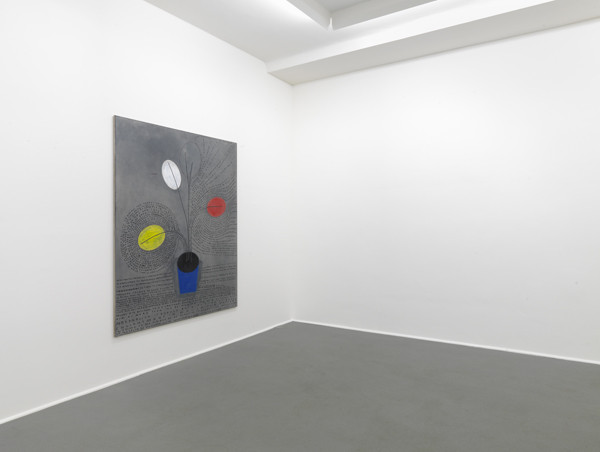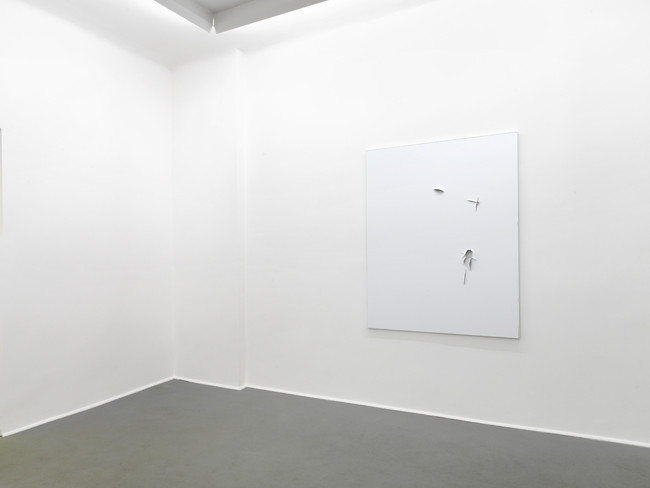Heinzmann Johnson Zipp
18 Jan - 02 Mar 2013
Galerie Guido W. Baudach is pleased to present an exhibition of selected new paintings by the gallery’s artists Thilo Heinzmann, Rashid Johnson and Thomas Zipp.
Thilo Heinzmann’s contribution shows an aluminium quadrangle cut down by hand from industrially manufactured, white-coated panels, then punctuated with slits using various hatchets. A slim, white metal frame provides the sedate setting for this intense visual corpus. The title of the work, Aicmo, is a word coined by the artist to specify all the incised aluminium paintings he has produced over the last years, and thus gives an entire group of works its name. Like its sister paintings, Heinzmann’s most recent Aicmo is also direct painting; an abstract confluence of speed and
movement. The point of departure is an approach to mark making as precise as it is resolute; an artistic practice which permits of no subsequent revisions whatsoever and which, when it succeeds, as it does here, results in a manifestation of unrestrained harmony and beauty.
Where Rashid Johnson employs black wax as his painting material in For Wedding, he too shows an immediacy that inevitably recalls the dripping techniques of Abstract Expressionism. But Johnson’s work is primarily to be understood through the symbols and metaphors hidden within it. Even the painting ground itself is drawn from Johnson’s everyday domestic environment: a playfully arranged, or rather, artfully composed parquet floor in oak. A variety of scratchings and multiple applications of a crosshairs emblem apparently relegated to the politically motivated hip-hop
– transform the profane wooden ground into the banner of an entire culture. But rather than simply being printed in the tradition of Andy Warhol, as with other contemporary American painting, this symbol of targeted aggressiveness is literally branded into the wood with a hot iron – in much the same way as white farmers in the Confederate States once asserted their supposed ownership of their black slaves. And the title here, For Wedding, refers not just to a friendly dowry, but to the problem district of the same name just to the north of central Berlin, a district characterised by social impoverishment and a failed integration policy. So in Johnson’s case something that initially looks like pure abstraction is at the same time an artwork profoundly loaded with political and socio-cultural questions.
Symbolism and sketchiness also characterise the work of Berlin based artist Thomas Zipp. The present painting is entitled A.B.: DRENCH, and, unlike Heinzmann and Johnson’s works, is predominantly made using the more conventional means of oil and acrylic on canvas. His symbols are the plant motif – that classic cipher for the
existential cycle of living and passing – and fragments of English text taken from a psychiatric textbook which describes a specific type of psychotherapy utilizing a combination of anaesthesia and hypnosis, here reproduced in Zipp’s signature block text calligraphy. This hand tells the graphologist next to nothing about the author and thus lends him a degree of supra-individuality. And the plant for Zipp primarily stands for the human sensory apparatus and the various narcotic substances that can be derived from certain species, and which, on entering the human bloodstream, provide different stimuli to sensory perception. As with many of Zipp’s other works, A.B.: DRENCH investigates the human condition, especially through anomalous states of consciousness. With its evident and diversified art-historical echoes, from Dada to Hard Edge, the painting is as it were the artist’s commentary on the inner constitution of modern man.
The juxtaposition of these three paintings evidences one key commonality in the work of Thilo Heinzmann, Rashid Johnson and Thomas Zipp: they all represent the continuation of various impulses drawn from modernism. But it also clearly demonstrates that the concrete forms and contents involved in their respective artistic processes, as well as their particular positions in the context of contemporary art, are fundamentally different. In the broad field of modern painting, each of these three artists is a solitary figure with his own unique, autonomous and incisive voice.
Thilo Heinzmann’s contribution shows an aluminium quadrangle cut down by hand from industrially manufactured, white-coated panels, then punctuated with slits using various hatchets. A slim, white metal frame provides the sedate setting for this intense visual corpus. The title of the work, Aicmo, is a word coined by the artist to specify all the incised aluminium paintings he has produced over the last years, and thus gives an entire group of works its name. Like its sister paintings, Heinzmann’s most recent Aicmo is also direct painting; an abstract confluence of speed and
movement. The point of departure is an approach to mark making as precise as it is resolute; an artistic practice which permits of no subsequent revisions whatsoever and which, when it succeeds, as it does here, results in a manifestation of unrestrained harmony and beauty.
Where Rashid Johnson employs black wax as his painting material in For Wedding, he too shows an immediacy that inevitably recalls the dripping techniques of Abstract Expressionism. But Johnson’s work is primarily to be understood through the symbols and metaphors hidden within it. Even the painting ground itself is drawn from Johnson’s everyday domestic environment: a playfully arranged, or rather, artfully composed parquet floor in oak. A variety of scratchings and multiple applications of a crosshairs emblem apparently relegated to the politically motivated hip-hop
– transform the profane wooden ground into the banner of an entire culture. But rather than simply being printed in the tradition of Andy Warhol, as with other contemporary American painting, this symbol of targeted aggressiveness is literally branded into the wood with a hot iron – in much the same way as white farmers in the Confederate States once asserted their supposed ownership of their black slaves. And the title here, For Wedding, refers not just to a friendly dowry, but to the problem district of the same name just to the north of central Berlin, a district characterised by social impoverishment and a failed integration policy. So in Johnson’s case something that initially looks like pure abstraction is at the same time an artwork profoundly loaded with political and socio-cultural questions.
Symbolism and sketchiness also characterise the work of Berlin based artist Thomas Zipp. The present painting is entitled A.B.: DRENCH, and, unlike Heinzmann and Johnson’s works, is predominantly made using the more conventional means of oil and acrylic on canvas. His symbols are the plant motif – that classic cipher for the
existential cycle of living and passing – and fragments of English text taken from a psychiatric textbook which describes a specific type of psychotherapy utilizing a combination of anaesthesia and hypnosis, here reproduced in Zipp’s signature block text calligraphy. This hand tells the graphologist next to nothing about the author and thus lends him a degree of supra-individuality. And the plant for Zipp primarily stands for the human sensory apparatus and the various narcotic substances that can be derived from certain species, and which, on entering the human bloodstream, provide different stimuli to sensory perception. As with many of Zipp’s other works, A.B.: DRENCH investigates the human condition, especially through anomalous states of consciousness. With its evident and diversified art-historical echoes, from Dada to Hard Edge, the painting is as it were the artist’s commentary on the inner constitution of modern man.
The juxtaposition of these three paintings evidences one key commonality in the work of Thilo Heinzmann, Rashid Johnson and Thomas Zipp: they all represent the continuation of various impulses drawn from modernism. But it also clearly demonstrates that the concrete forms and contents involved in their respective artistic processes, as well as their particular positions in the context of contemporary art, are fundamentally different. In the broad field of modern painting, each of these three artists is a solitary figure with his own unique, autonomous and incisive voice.



